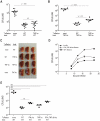A gamma interferon independent mechanism of CD4 T cell mediated control of M. tuberculosis infection in vivo
- PMID: 21625591
- PMCID: PMC3098235
- DOI: 10.1371/journal.ppat.1002052
A gamma interferon independent mechanism of CD4 T cell mediated control of M. tuberculosis infection in vivo
Abstract
CD4 T cell deficiency or defective IFNγ signaling render humans and mice highly susceptible to Mycobacterium tuberculosis (Mtb) infection. The prevailing model is that Th1 CD4 T cells produce IFNγ to activate bactericidal effector mechanisms of infected macrophages. Here we test this model by directly interrogating the effector functions of Th1 CD4 T cells required to control Mtb in vivo. While Th1 CD4 T cells specific for the Mtb antigen ESAT-6 restrict in vivo Mtb growth, this inhibition is independent of IFNγ or TNF and does not require the perforin or FAS effector pathways. Adoptive transfer of Th17 CD4 T cells specific for ESAT-6 partially inhibited Mtb growth while Th2 CD4 T cells were largely ineffective. These results imply a previously unrecognized IFNγ/TNF independent pathway that efficiently controls Mtb and suggest that optimization of this alternative effector function may provide new therapeutic avenues to combat Mtb through vaccination.
Conflict of interest statement
The authors have declared that no competing interests exist.
Figures





Comment in
-
What do we really know about how CD4 T cells control Mycobacterium tuberculosis?PLoS Pathog. 2011 Jul;7(7):e1002196. doi: 10.1371/journal.ppat.1002196. Epub 2011 Jul 28. PLoS Pathog. 2011. PMID: 21829359 Free PMC article. No abstract available.
References
-
- van de Vosse E, Hoeve MA, Ottenhoff TH. Human genetics of intracellular infectious diseases: molecular and cellular immunity against mycobacteria and salmonellae. Lancet Infect Dis. 2004;4:739–749. - PubMed
-
- Filipe-Santos O, Bustamante J, Chapgier A, Vogt G, de Beaucoudrey L, et al. Inborn errors of IL-12/23- and IFN-gamma-mediated immunity: molecular, cellular, and clinical features. Semin Immunol. 2006;18:347–361. - PubMed
-
- Caruso AM, Serbina N, Klein E, Triebold K, Bloom BR, et al. Mice deficient in CD4 T cells have only transiently diminished levels of IFN-gamma, yet succumb to tuberculosis. J Immunol. 1999;162:5407–5416. - PubMed
Publication types
MeSH terms
Substances
Grants and funding
LinkOut - more resources
Full Text Sources
Medical
Research Materials
Miscellaneous

